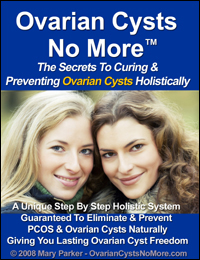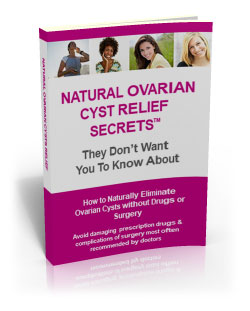Clickbank Affiliate Marketing
|
by Mary Parker
Ovarian cysts are basically small sacs that have fluids within them that form inside the female ovary. Most of these cysts are benign in nature, i.e., they do not lead to any harm. However, in some cases, complications like rupturing, bleeding and pain may occur. In extreme situations, surgery is one way that may be considered tonhelp get rid of the cysts.
Physiological ovarian cysts
All women of child bearing age, who are not on birth control pills, have certain cystic structures in their ovaries, which continuously come and go. Such structures are essential for the development and subsequent release of the egg. Cysts occurs as part of this general function of the ovaries and are known as a "physiological cysts."
What happens is this. A maturing egg is carried to the surface of the ovary by a cystic structure known as a " follicle," during the earlier half of a normal 28 days cycle. This follicle carries out the dual task of not only getting the egg transported, but also of manufacturing estrogen.
Estrogen, which is a hormone, stimulates uterine lining growth in prepration of the unterus in case the egg is fertilized. This start of intrauterine will help in the implantation of the fertilized egg and the growth of the embryo.
During ovulation, the follicle, a physiological cyst, is the size of an olive. The egg is released when the follicle gets ruptured. The fluid of the follicle which, till then, had been clear, is replaced with blood which accompanies the rupturing process. Progesterone begins to be secreted at this point and a substance, which is yellow colored, is formed during this time.
If there is no pregnancy at this time, the yellow matter begins to look scarred. The remaining cystic structure is often referred to as corpus luteum, and it is quite small. In many cases, though, this process gets carried away. This is when this physiological structure fills with the follicular fluid or blood and become a physiological cyst. It may look like a small plum.
A similar physiological cyst may arise if the egg being carried is not released from the follicle,
These cysts may or may not be accompanied with pain. Often an irregular menstrual cycle is the instant side effect of these cysts. These cysts may also twist or leak within the ovary. And when this happens, the abdomen may become tender and there can be some pain, too. Surgery may become necessary now - but an ultrasound is needed to identify the how large cyst is and whether it needs to be removed. Typically, physiological cysts disappear within 8-10 weeks.
Pathological Ovarian Cysts
Cystic structures which form within the ovary and that are not a part of an ovulation cycle, are referred to as "pathological ovarian cysts." These growths are also termed 'tumours'. Tumours again may be divided into two categories - non-cancerous or benign and cancer or malignant.
Pathological ovarian cysts contain sundry materials - in a few there is mucous, and in others there is stale blood, and other materials maybe found in the cysts. Pathological cysts are caused by diseases - from a simple hormonal imbalance to cancer. Pathological cysts biggest drawback is that they they do not disappear, so easily, on their own as do physiological cysts - there maybe no regression. The fluids may just continue to accumulate causing the cyst to increase in size. Pathological cysts can happen in women of any age, but more often occur to women who are post-menopausal.
Looking at the formation of typical ovarian cysts.
If you look at your ovaries during an ultrasound, you will see that ovarian cysts resemble bubbles. Each cyst is like a small pouch in the ovary wall filed with fluids. The tissue enclosing the fluid is usually very thin. They are called 'Simple Cysts' or 'Functional Cysts' as they a part of the monthly cycle of eggs being released. If the follicle carrying an egg does not rupture and there is no release of the egg, the fluid remains within and this may form into a cyst in the ovary. This may affect one of the ovaries. Tiny cysts are normally present when the follicles are being formed.
Adverse Effects
Women can get affected by ovarian cysts at any age. If a doctor pronounces these cysts to be physiologic or functional, then such cysts are not the result of diseases and most often are benign. Many of these disappear by themselves within the space of a few weeks.
Pathological cysts are the result of some type of disease and they fall into the categories of cancerous growths or non-cancerous.
Ovarian cysts are most often a part of a a normal, natural process and a harmless condition. Although they can be irritating and painful.
Of course, ovarian cancer is a very serious condition.
Ovarian cysts can be of various types and include Corpus Luteum cysts, Dermoid cysts, Follicular cysts, Hemorrhagic cysts and many others.
Holistic Approach
In today's modern world, you can choose from various medication alternatives to get a cure for ovarian cysts. But none of these guarantee 100% success. In fact, the holistic system is the only one that cures ovarian cysts completely. The holistic approach is also free of any kind of side effects. Hence you can trust the holistic approach completely. The holistic approach eradicates the root cause of the ovarian cyst thus, completely eliminating the chance of their recurrence. The holistic approach believes in an overall approach covering every aspect of physical fitness, mental health and spiritual growth as well.
About the Author: Mary Parker is a certified nutritionist and author of the #1 best-selling e-book, Ovarian Cysts No More.



